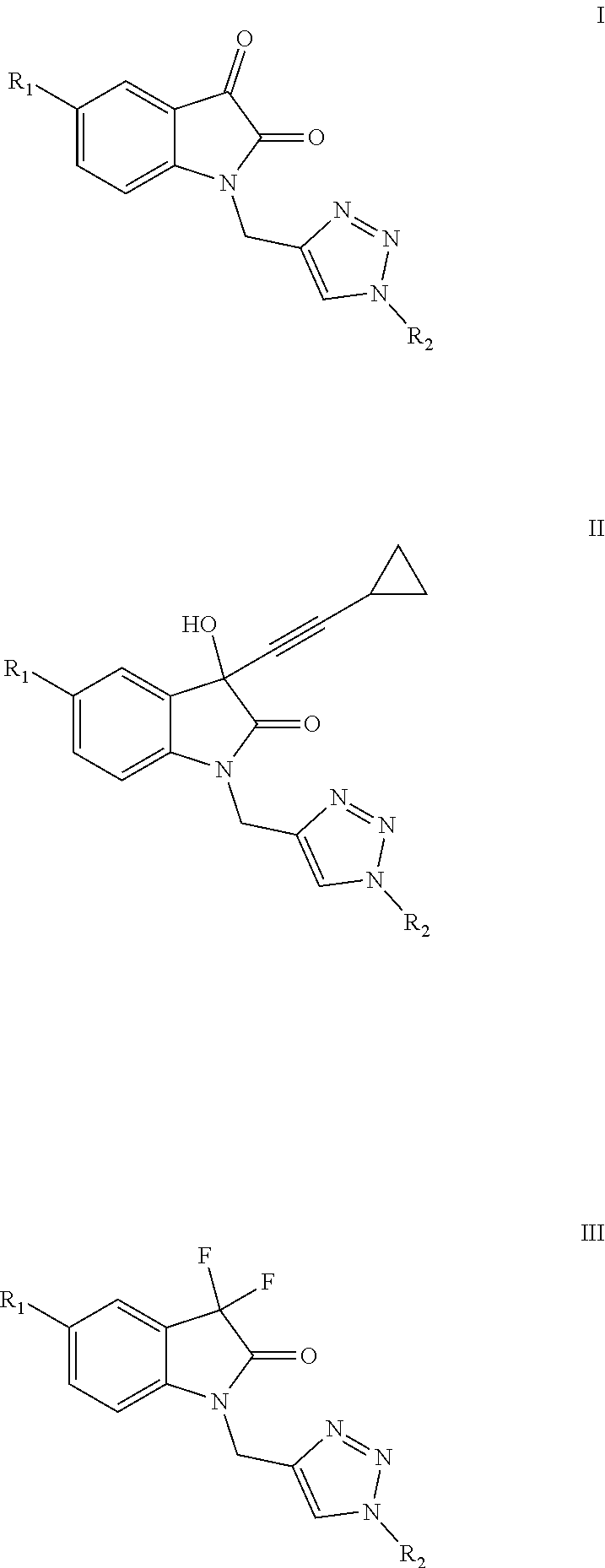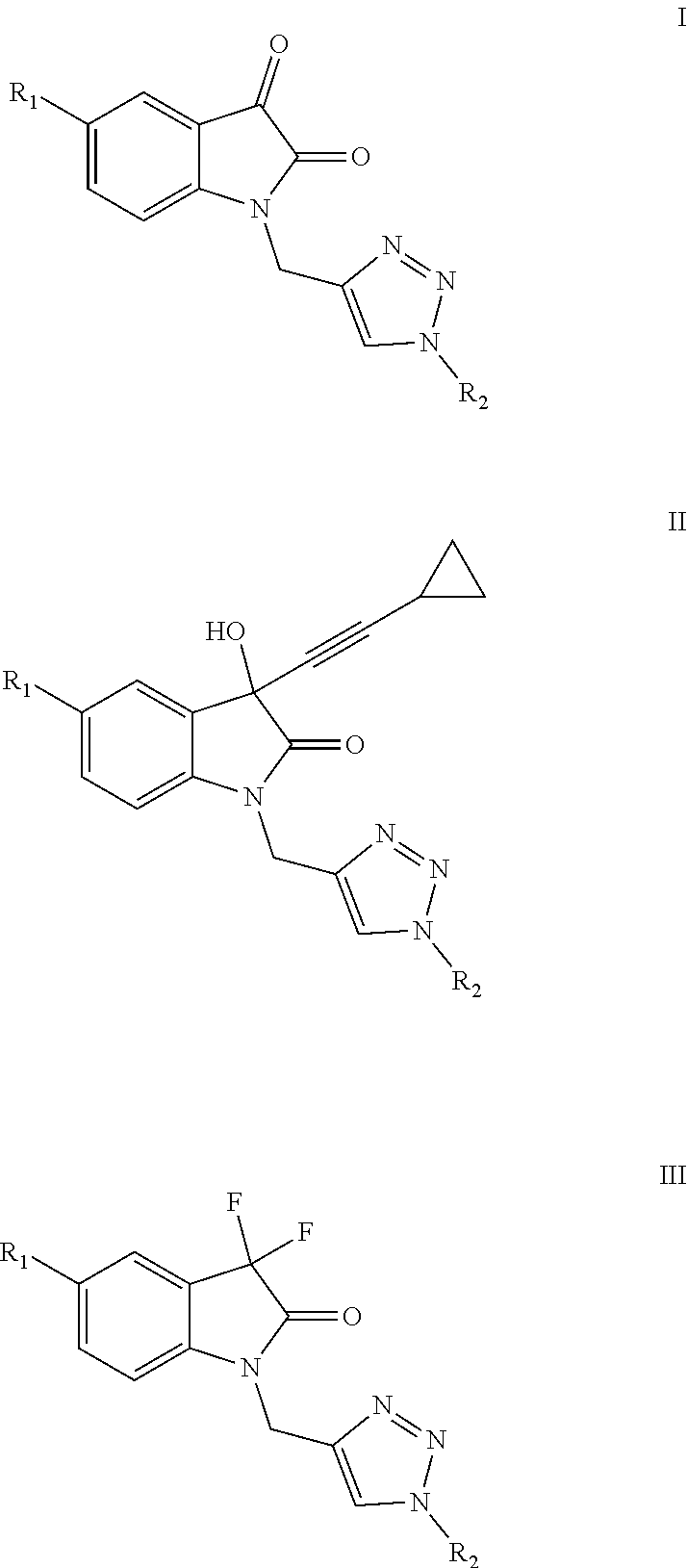Isatin-derived compounds, use of the compounds for the treatment of AIDS and method of treatment using these compounds
a technology of isatin and compound, applied in the field of inhibiting compounds, can solve the problems of aids still remaining a global health problem that challenges the scientific community, and no active ingredient has been identified so far that can eradicate the virus from the body
- Summary
- Abstract
- Description
- Claims
- Application Information
AI Technical Summary
Problems solved by technology
Method used
Image
Examples
example 1
viral Assessment
[0101]Preparation of Cells and Virus
[0102]The T-lymphocyte cell line (Suptl) was cultured in an RPMI 1640 medium (GIBICO). The cultures were supplemented with 10% Fetal Bovine Serum (SFB; HyClone, Logan, Utah, USA), 100 U / mL of penicillin and 100 μL / mL of streptomycin, and incubated at 37° C., in an atmosphere of 5% CO2. Virus stocks were prepared using the methodology described by Souza and Denizot (SOUZA, T. M. L; RODRIGUES, D. Q.; FERREIRA, V. F.; MARQUES, I. P.; DE SOUZA, M. C. B. V.; FRUGULHETTI, I. C. P. P.; BOU-HABIB, D. C; FONTES, C. F. L. Characterization of HIV-1 enzyme reverse transcriptase inhibition by the compound 6-chloro-1.4-dihydro-4-oxo-1-(β-D-ribofuranosyl) quinoline-3-carboxylic acid through kinetic and in silico studies. Current HIV Research, v. 7, No 3, page 327-335, 2009. DENIZOT, F.; LANG, R. Rapid colorimetric assay for cell growth and survival. Modifications to the tetrazolium dye procedure giving improved sensitivity and reliability. The Jo...
example 2
of Formula I(A-i) Compounds
[0105]Before presenting the synthesis of Formula I(a-i) compounds, it is necessary to describe the syntheses of the V(c) intermediaries that gave rise to them.
Synthesis of V(a-c) Compounds
[0106]Using a 50 mL mono-tube flask, were added 6.8 mmol of the corresponding IV(a-c) isatins (1 eq), 11 mmol of propargyl bromide (1.63 eq), 12.92 mmol of potassium carbonate (1.9 eq), 2.1 mmol of sodium iodide (0.32 eq) and 0.2 mmol of 18-crown-6 (0.04 eq) in 6 mL of anhydrous DMF. The medium was kept under magnetic stirring, at room temperature for 2 hours. The completion of the reaction was shown through TLC, using the hexane:ethyl acetate (7:3) elution system. In order to isolate the product, the reaction mixture was washed with 30 mL of DMF and vacuum filtered. The resulting liquid was evaporated to give a brown oil, which was extracted with chloroform (50 mL) and washed with water (3×25 mL). The organic phase was dried with anhydrous sodium sulfate and the solvent ...
example 3
of Formula II(A-f) Compounds
[0192]Before presenting the synthesis of the compounds de Formula II(a-f) it is necessary to describe the syntheses of the intermediaries VIII(a-c) that gave rise thereto.
Synthesis of Compounds VIII(a-c)
[0193]In a 100 mL bi-tube flask containing 10 mL of previously-dried THF, 40.8 mmol of cyclopropylacetylene (2 eq) and 40.8 mmol of n-BuLi (2 eq) (2.5M) were added. The reaction medium was initially kept under magnetic stirring at a temperature of −5° C. for 30 minutes. The reaction mixture was then cooled to a temperature of −78° C., and 20.4 mmol of the corresponding IV(a-c) isatins (1 eq) were added, with solubilized in 35 mL of anhydrous THF. The reaction was left under magnetic stirring overnight, and its termination was indicated by TLC, using hexane:ethyl acetate (1:1) elution system. After this period, a 1M citric acid solution was added until reaching pH 7. The organic phase was washed with water (3×10 mL), dried with anhydrous sodium sulphate and...
PUM
| Property | Measurement | Unit |
|---|---|---|
| concentration | aaaaa | aaaaa |
| temperature | aaaaa | aaaaa |
| temperature | aaaaa | aaaaa |
Abstract
Description
Claims
Application Information
 Login to View More
Login to View More - R&D
- Intellectual Property
- Life Sciences
- Materials
- Tech Scout
- Unparalleled Data Quality
- Higher Quality Content
- 60% Fewer Hallucinations
Browse by: Latest US Patents, China's latest patents, Technical Efficacy Thesaurus, Application Domain, Technology Topic, Popular Technical Reports.
© 2025 PatSnap. All rights reserved.Legal|Privacy policy|Modern Slavery Act Transparency Statement|Sitemap|About US| Contact US: help@patsnap.com



